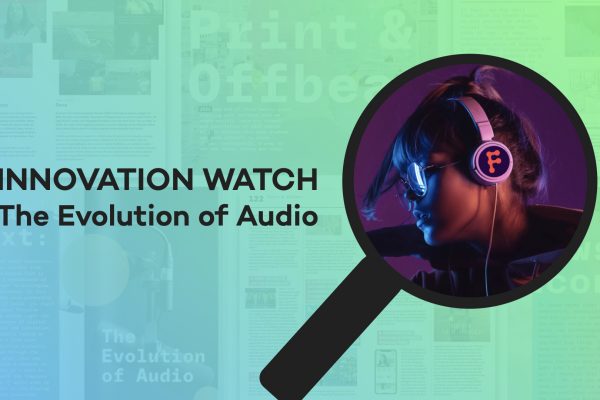Innovation Watch: The evolution of audio
In the third instalment of our Innovation Watch series, we look at the evolution of audio. Now, we know that the podcast sector is BIG, so the key here is to focus on topline trends, along with some of the other key innovations going on in audio today – in other words, think of this as a short, sharp 20min listen while preparing dinner… as opposed to a long, drawn-out slog through an entire series worth of hour-long episodes!
In introducing its chapter on audio, the 2022-23 Innovation in Media World Report shop-windows the following key trends:
- The continued boom in podcast advertising, significantly enhancing its potential as a driver of revenue
- The removal of technical roadblocks to offer paid podcast subscriptions, thanks to new initiatives by platforms like Apple Podcasts and Spotify
- Publishers going in heavy on converting text articles to audio either through human voice or AI solutions. Often in response to readers demanding more audio over text
- The combining of audio articles and podcasts into appealing subscription packages. Either linked to existing digital subscription plans or fashioned, in some cases, into standalone audio apps put out by publishers
- The boom in live or social audio, inspired by Clubhouse but now led by new tools like Twitter Spaces
- More developments in short form audio that increasingly looks like the future: finding a sweet spot somewhere between a podcast, text article and a video.
So as discussed, there’s an awful lot ging on in the space right now… but one way to simplify the concept of audio may be to think of it as ‘the fourth dimension of media’.

In other words, we already have:
- Width: online publications through which linear reading takes place – there may be images and videos within these articles, but you’re largely there to get your regular text information/entertainment fix.
- Length: predominantly video, social, and mobile content that’s consumed vertically on the Scrolly-scroll.
- Depth: more immersive forms of media – the classic example being a magazine, which is lovingly crafted to provide a more in-depth experience, placing as much emphasis on its glossy double-page spreads as it does on its written features and boxouts. But of course, this could be delivered through other formats too, such as cinema, events, and VR.
Audio is more like a roving fourth dimension, allowing you to add extra angles to your existing content. It’s a way to expand the sensory parameters of a text article, keep people’s ear to your brand while they’re browsing the wider web, or a more engaging way for example to interact with the afore-mentioned Twitter (Spaces).
In the case of podcasts in particular, one could even go as far as to argue that audio is really a form of Augmented Reality (AR). As in people pop in the earbuds, press play on their favourite subject matter, and find the sensory reality in front of them immediately enhanced. It’s just that in this instance the augment is implemented through the sense of hearing, rather than as a Pokémon popping up on your iPhone screen.

From augmented reality to financial actuality
If we take this concept of audio as a starting point, then how can it be used to grow existing revenue streams? Well, the simple answer to that question is that we take the theoretical fourth dimension, and implement it into the confines of a tangible 3D process…
For example:
- Film a 30min podcast episode (as in literally film it, on your iPhone)
- Publish that video online via whatever monetisation model you see fit (subscription, YouTube, direct advertising, etc.)
- Split the audio file from the video, use it to create a podcast, and repeat monetisation consideration (largely still scale rather than subscription at this point, although not always)
- Slice and dice the video content for various different social platforms
- Use that to promote the podcast
- Publish an article on the episode, identifying key trends for an alternative shortform read
- Make that read available in audio
- In some sort of player format that allows people to browse the wider world while still locked into your brand
It’s not an exact science, and there are of course greater minds than mine in the industry today already on the case (which incidentally you can read more on via the FULL Innovation in Media World Report here!)
But however you physically incorporate (and monetise) it, it’s clear that audio represents one of the most exciting evolutionary areas in our industry today. And for this editor at least – while there are examples of successful standalone podcasts out there, Drink Champs being one that I have listened to a fair few episodes of myself – it will be those publishers who adopt audio as a holistic whole, and use it to push the boundaries of their overall content offerings, that succeed long-term in this area.
Further reading
We’ve looked at a lot of interesting examples of audio success this year on FIPP.com, and in addition to the Innovation report, I would recommend the following:
- Quartz Obsession: The content, commercial, and conversational considerations that go into a successful modern podcast
- Inside Empire: a new events series exclusive to the magazine’s VIP Club members that adds additional subscriber benefits such as a subscription to the magazine, the Spoiler Special podcast, and an annual Picturehouse or My Cineworld Plus membership
- Audio’s second coming: How NYTimes and Tortoise attract younger audiences through podcasts
- The Offside Rule co-founder Kait Borsay on 10 years of the podcast, women’s football success and why mentorship is so important
Additionally, I would of course encourage you to go and take a listen to our very own FIPP podcast, in partnership with PressReader: Media Unscripted.
Hosted by Charlotte Ricca, these exclusive industry insider episodes provide a human take on media today, as well as some of the most interesting content and commercial trends developing before our very eyes (and ears).











